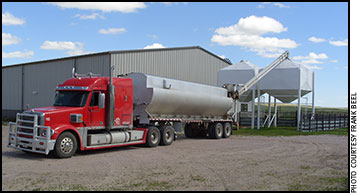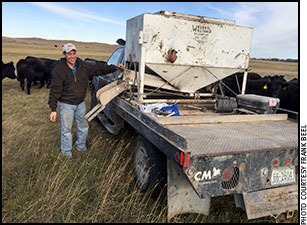
Caking Cows — One Way to Provide Winter Protein
Protein cake offers winter supplementation options on the range.
Many ranchers supplement cows during winter, feeding protein to balance dry pastures. Range pellets or cake are often used for this purpose.
Cows have different nutritional needs at different stages of gestation, but they all need protein — the amount increasing in late gestation. Protein requirements are higher for young cows because they are still growing. All cattle need a certain level of protein in the rumen to digest and utilize fiber. Whether protein supplementation is needed will depend on protein levels in winter forage.
Range pellets are handy for some ranchers, with various protein levels to meet various needs, and many feedmills around the country manufacture pellets. Cammack Ranch Supply, Union Center, S.D., makes a 15%, 20% and 30% protein pellet, all grain-based. The 15% and 20% pellets are wheat-based. Canola is the protein source for the 30% pellet.

“Now it comes in bulk and it’s a lot easier. Farmers Ranchers Co-op brings it to us a semi load at a time to save on freight, and fills our bins. We have two overhead bulk bins that we just drive under to fill the feeder on our truck,” he says.
Ranchers can feed pellets out in the pasture, on grass or bare ground; the round cubes hold together nicely but are easy to eat. Cammack Ranch Supply sells cake bulk, loose or bagged [50-pound (lb.) bags, up to 2,000 lb. bulk-bagged]. Many ranchers use an overhead cake bin that fills a cake feeder in the back of a pickup. The feeder has a trip hopper and dumps cake in a stream as the pickup drives along, measuring a certain amount of pounds. Some feeders mount the feeder on a flatbed, and some prefer over-the-side mounts for a pickup.
Farmers Ranchers Cooperative, Ainsworth, Neb., manufactures three types of cake, with crude protein levels of 30%, 23% and 14%. The 30% cake is soybean meal, sunflower meal and dried distillers’ grain and contains 3% fat and 40,000 000 international units (IU) vitamin A. Recommended feeding rate is 1 to 2 lb. per head per day.
The 23% cake is mainly dried distillers’ grains, contains 5% fat and 30,000 IU vitamin A. This product is fed at a rate of 2 to 3 lb. per head per day.
The 14% cake contains corn, wheat midds and dried distillers’ grain, 4% fat and 20,000 IU vitamin A. Recommend feeding rate is 4 to 6 lb. per head per day. The company also makes custom formulations with various vitamins, trace minerals, medicated feed additives or ionophores. Custom pellets can be created to match the needs of any herd.
Frank Beel raises Angus cattle near Johnstown, Neb.

“It’s a very palatable pellet, and they don’t waste any. We try to feed on grass or firm ground. If we get into a patch of sand or mud, we shut off the feeder and keep going until we get onto good ground again. We can turn it on and off from the truck cab,” he explains.
“Our family has been here 76 years. I’m 46 and my parents were feeding cake ever since I can remember. It used to come in 100-pound bags. We’d put those in the back of the pickup and take two people — one to drive the pickup and one to scatter cake,” Beel says.
“Now it comes in bulk and it’s a lot easier. Farmers Ranchers Co-op brings it to us a semi load at a time to save on freight, and fills our bins. We have two overhead bulk bins that we just drive under to fill the feeder on our truck,” he says. The feeder mounted on the back of their flatbed holds about 1,200 lb.
Beel feeds about 3 lb. per head, every other day. He starts feeding cake to his spring-calving cows in December because they don’t calve until March. The fall-calving herd begins eating cake in October, to have them ready to breed again.
The cows come to the truck.
“It’s a very palatable pellet, and they don’t waste any. We try to feed on grass or firm ground. If we get into a patch of sand or mud, we shut off the feeder and keep going until we get onto good ground again. We can turn it on and off from the truck cab,” he explains.
Even if it snows, there are usually places the snow has blown off, where cake can be fed on grass. “Sometimes we have to quit caking them for three or four days if snow gets too deep, but usually, after the cattle tromp around we can go back to feeding. We might go down a windrow where we’ve fed hay earlier or the tractor tire track where the snow is mashed down,” he says.
The fall calves eat cake with their mothers.
“We used to wean our fall calves the first of March but realized it was cheaper to leave them on the cows a few more months. The mothers teach them how to graze in the spring, and I think the calves stay healthier on the pastures with their mothers,” Beel says.

Editor’s Note: Heather Smith Thomas is a cattlewoman and freelance writer from Salmon, Idaho.






